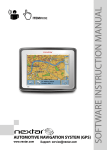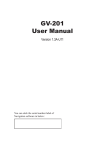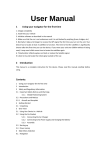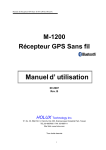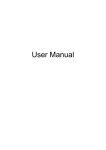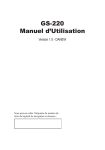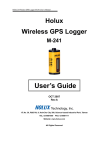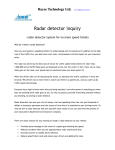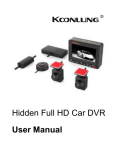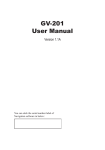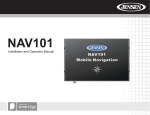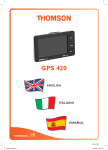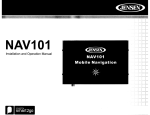Download Personal Navigation Device User Guide 4.1 –US version Navigation
Transcript
Personal Navigation Device User Guide 4.1 –US US version Contents: Typographic conventions ................................................................................ 5 Icons ............................................................................................................... 6 Introduction ..................................................................................................... 7 Key features ............................................................................................... 7 Getting started ................................................................................................ 8 Choosing a language.................................................................................. 8 Set time zone ............................................................................................. 8 Safety precautions ...................................................................................... 8 GPS connection ......................................................................................... 9 Main elements .............................................................................................. 10 Main menu................................................................................................ 10 Map .......................................................................................................... 11 Tracking mode and browsing mode...................................................... 11 Navigation screen ..................................................................................... 13 Main features ................................................................................................ 14 Choosing and finding locations ................................................................. 14 Search for an address .......................................................................... 14 Searching for and choosing POIs ......................................................... 19 Choosing a location on the map ........................................................... 21 Favourites ............................................................................................ 21 Navigating ................................................................................................ 25 Browse the map during navigation ....................................................... 25 Menu options........................................................................................ 26 Planning a route ....................................................................................... 27 Settings .................................................................................................... 29 General settings ................................................................................... 30 Map settings ......................................................................................... 31 Route options ....................................................................................... 32 Volume ................................................................................................. 34 Extra services ............................................................................................... 35 Guides ...................................................................................................... 35 Traffic Message Channel (TMC) ............................................................... 35 Route recording ........................................................................................ 36 Speed camera alert .................................................................................. 36 Frequently asked questions .......................................................................... 38 Index............................................................................................................. 39 Copyright and license notes ......................................................................... 41 TYPOGRAPHIC CONVENTIONS TYPOGRAPHIC CONVENTIONS TYPOGRAPHIC CONVENTIONS Bold Items you must select, such as menu options, command buttons or items in a list. • Bullet Step-by-step procedures. You can follow these instructions to complete a specific task. Comment Especially important or noteworthy information. Monospace Information that you must type, or information like folders and filenames. CAPITALS Names of keys on the keyboard. For example, SHIFT, CTRL or ALT. ICONS ICONS The following icons are used throughout the application: Name Function Menu icon Open a menu with various options. Back icon Go back to the previous screen. Navigation icon Start navigation. GPS icon Availability/strength of GPS signal. Search icon Open a search screen. Confirmation icon Apply settings. Select/deselect all. Cancel icon Cancel route calculation. INTRODUCTION INTRODUCTION You have chosen a cutting-edge navigation system. Congratulations! Please enjoy using it. This navigation system leads you straight to your destination, whether you are travelling by car or on foot. You can navigate and plan your route with an easy-to-use and intuitive interface, just by using your finger. You can also use this application to plan your trip to suit your personal preferences and interests and to save interesting destinations before you set off on your journey. This manual leads you through the main features of the system. Key features • Cross-border navigation in Europe based on a 1-GB map of Europe (extra service) • Dynamic Traffic Information, TMC (extra service) • Real pedestrian mode • Trip planning • Look-ahead search function • State-of-the-art polygon view of individual houses for selected European cities (extra service) • Earth browsing • Unique night mode • Improved guidance engine • Premium content based on branded guides (extra service) GETTING STARTED GETTING STARTED Please make sure that the battery in your device is fully charged. • Switch on the unit and tap on NAVI or NAVIGATION in the first screen. Choosing a language If more than one language is available on your device, you are prompted to choose your language. • Click on the flag representing your country/language. • On the following screen, choose the voice skins used for the voice commands during navigation (e.g., female or male voice). Set time zone Your PND is able to automatically determine the time through the GPS signal. For this purpose, you need to set your time zone. • Choose your time zone from the list. It can be changed at a later time (see page 31). • Press the Confirmation icon. Safety precautions Next, a screen with safety precautions will be shown. • Read the safety precautions. • Select Hide at startup to hide these notes for future startups. • Press the forward arrow. GETTING STARTED GPS connection Your PND uses GPS technology for navigation. The device receives signals from a number of GPS satellites in order to determine your current position. • Place your PND in a location with an unobstructed view to the sky to set up your first satellite connection. In a car this will usually be on the dashboard. It may take up to 5 minutes to establish the first connection. Subsequent connections will be faster (30 seconds to 1 minute), but if you have not used the unit for several days or are very far away from the last location where you used it, it may take up to 5 minutes again to find a strong signal. MAIN ELEMENTS MAIN ELEMENTS Main menu The main menu is your central point of access to all functions of your Personal Navigation Device. It allows you to set your destination, manage your favorites and control all settings of your device. On the left-hand panel there are three large buttons. Click on one of the buttons to open a set of sub-options: • Destination lets you choose your destination – either by searching for an address (see page 14), choosing an entry from the POI directory or a city guide (see page 19), selecting a location from the map (see page 21) or a recently visited location (see page 24). • Favorites allows you to manage your favourites (like bookmarks, recently visited locations, trips). You can rename, sort or delete them (see page 21). MAIN ELEMENTS • Use Settings to configure your Personal Navigation Device to suit your needs. Define general settings (e.g., time, language, system of measurement, see page 30), configure your map (e.g., 2D or 3D mode, day or night mode, map complexity) or load a map of a different region (see page 31), set the route options (e.g., choose to avoid or allow toll roads or ferries or select your mode of transportation; see page 30) or adjust the volume (see page 34). Map The map is the core component of your Personal Navigation Device. It is centred on your current location by default, provided you have a GPS connection. You can browse the map, display information about the different locations shown on it and, e.g., choose them for routing and navigating. Tracking mode and browsing mode The map has two basic states: tracking and browsing. In the tracking mode, the map follows your actual position (GPS position), displaying information about your geographic position, your speed, etc. The GPS position is indicated through the crosshairs. MAIN ELEMENTS Speed GPS status Battery status Time Zoom out Elevation above mean sea level Geographic coordinates GPS position Zoom in Back icon Menu icon As soon as you browse the map, you enter the browsing mode: GPS status Battery status Zoom out Cursor GPS position Zoom in Back icon • I Menu icon Use a pen or your finger to browse the map. The selected position will be identified by a cursor. Clicking on an icon on the map opens an overlay window with information about the selected item. • To zoom in or out, press the + or - icons. As soon as you press one of the icons, the zoom slider is displayed to enable smooth zooming. • Use the Compass icon (in the bottom left-hand corner) to adjust the orientation. MAIN ELEMENTS • If you want to return to the tracking mode, press the Back icon. Navigation screen Manoeuvre icon Distance to next manouvre Next turn/junction/exit no. Zoom out Speed Current time Estimated arrival time Direction Distance to destination GPS position Zoom Back icon Menu icon The navigation screen displays your route (in blue) and your surroundings. Crosshairs identify your current position. The red arrow indicates the direction of your next turn. The upcoming manoeuvre is also visualised in the upper left corner – together with the distance to it. When you approach a turn, there will be a voice command at the appropriate time. On the left side, additional information is displayed, such as current / estimated arrival time and the distance to your destination. In one-way streets, the direction of travel is indicated by a red arrow. For more information about navigation see page 25. MAIN FEATURES MAIN FEATURES This chapter describes the functions of your Personal Navigation Device in detail. On the following pages you will learn how to - Find and choose locations (see page 14) - Navigate to your destination (see page 25) - Use the route planner (see page 27) - Configure the application (see page 29) Choosing and finding locations This section describes the different ways of finding and choosing locations. You can search for an address, browse POI directories and city guides, choose locations on the map and choose one of your favourites (like home and work address, your bookmarks and recently visited locations). Search for an address Use the address search function to find an address. Just enter information about the desired target, select a hit from the results list and use the address found for different purposes, like showing it on a map, planning your route and navigating. • In the main menu, press Destination. • Press Address. MAIN FEATURES The Find Address window will be called up: • Enter the appropriate data to find your address. How to search Your Personal Navigation Device offers a convenient interactive look-ahead search function to prevent misspelling. Only keys that lead to a search result can be pressed – all others are greyed out! • Enter the first character. You will see that the some keys on the keypad turn grey. You can only choose black keys: MAIN FEATURES • Enter the second character. Again, some keys will turn grey; others will turn black, depending on your choice. • Keep on entering characters until you have narrowed down the search to only one result. • Press the Search icon (magnifying glass). OR A result list will be displayed. • Choose the appropriate entry from the list. Switch between letter and number mode by pressing 123 or ABC. Switch between upper case and lower case by pressing ^. If at any point you want to go back and delete characters, press the backspace button <- on the screen. To add a space, press the space bar _. If you need to enter an apostrophe (‘) use the space key instead. MAIN FEATURES Set the country • To select your country, press State/Prov.. • Choose your country from the list. The State/Prov. field will be populated with the name of the chosen country. Enter a zip code Instead of a city you may enter a zip code. • To enter a zip code, press Zip code. • Enter the zip code of the town/city you are looking for. • Press the Search icon (magnifying glass). A hit list will be displayed. • Choose the appropriate town/city from the list. You will return to the Find Address screen, and the City and Zip code fields are populated with the chosen city/zip code. You can also enter a unique 7-digit zip code. In that case, you do not need to enter a street name (extra service). Search for the city • To select a city, press City. • Search for the city as described above. A result list will be displayed. • Choose the appropriate town/city from the list. You will return to the Find Address screen, and the City field is populated with the name of the chosen town/city. Search for the street • To select a street, press Street. • Search for the street as described above. MAIN FEATURES A result list will be displayed. • Choose the appropriate street from the list. You will return to the Find Address screen, which now contains the data previously entered. You may also enter the number. Navigate to the address found Once you have narrowed down your search to a unique address, you can start navigation. Press the Menu icon to access further options: • To navigate to the location, press Navigate (see page 25). • To use the location for planning a route, press Via (see page 27). • To save the location as a bookmark, press Save (see page 21). • To show the location on the map, press On Map. MAIN FEATURES Searching for and choosing POIs The POI finder allows you to quickly find points of interest like petrol stations and restaurants in a database of millions of POIs. These places can be nearby or at a distant location. • In the main menu, press Destination. • Press POI Search. The POI Search screen will be displayed: Choosing a POI • Select the desired POI category. A menu with subcategories will be shown. • Select a subcategory (if applicable). • To return to the previous category, press the Back icon. A list of POIs will be shown. • Select a POI by clicking on it. A menu with a set of actions will be displayed: MAIN FEATURES • To navigate to the location, press Navigate (see page 25). • To use the location for planning a route, press Via (see page 27). • To save the location as a bookmark, press Save (see page 21). • To show the location on the map, press On Map. • To show information about the location, press Description. To set a starting point, press Where?. POIs near that point will be displayed. Searching for a POI • To enter a search keyword, press the Search icon. • Enter the search keyword (at least three characters), and press the Confirmation icon. A list of POIs will be shown. • Select a POI by clicking on it. MAIN FEATURES A menu with a set of actions will be displayed as described above. Choosing a location on the map An easy way to choose a location is to select it on the map. Browse your surroundings and choose any street or location to use it for navigation or routing. • In the main menu, press Destination. • In the main menu, press Map. • Point the cursor at any place on the map. The name of the selected location/street will be shown in the info box. • Press the Menu icon. From the following menu you can choose to be guided to the address, use it for route planning, show it on the map, etc. (see page 25). Favourites Use your frequently used or favourite destinations for guidance. You can choose among your bookmarks, recently visited locations, previously saved trips (see page 27) and presets (e.g., your home or place of work). • In the main menu, press Destination. • In the main menu, press Favorites. MAIN FEATURES The Favorites menu will be displayed on the screen: Bookmarks The bookmarks list contains the destinations you have saved as favourites (from the guides, by choosing them on a map, etc.). This means that you do not need to perform repeated searches for those destinations. • Press Bookmarks. MAIN FEATURES The bookmark list will be displayed on the screen: Use the up and down arrows to scroll up and down in the list. • Select an item by clicking on it. A menu with a set of actions will be displayed: • To navigate to the location, press Navigate (see page 25). • To use the location for planning a route, press Via (see page 27). • To sort the list of location alphabetically, press Sort. • To show the location on the map, press On Map. • To delete the selected location, press Delete selected. • To edit the location, press Rename. • To delete all locations, press Delete all. All user information such as settings, bookmarks and recently visited locations are stored on the memory card and not on the device. MAIN FEATURES Recent Pressing Recent opens a list of recently visited or looked-up destinations. • Press Recent. The list of recent items will be displayed on the screen. Use the up and down arrows to scroll up and down in the list. • Select an item by clicking on it. A menu with a set of actions will be displayed as described above. Trips • To access your previously saved trips, i.e., routes, press Trips (see page 27). Presets You can save your home and street addresses as presets for quick access. • Press Presets. • Press My Home. A menu with a set of actions will be displayed: • To navigate to the location, press Navigate (see page 25). • To edit the location, press Rename. • To delete the location, press Delete selected. • To show the location on the map, press On Map. • To use the location for planning a route, press Via (see page 27). • To delete all locations, press Delete all. MAIN FEATURES If no home address has been set, you are prompted to do so. You can choose it by searching for an address, through your current GPS position or by choosing a recently visited location. Proceed similarly with your work address. Navigating The powerful navigation capabilities of your Personal Navigation Device guide you along the shortest or quickest route from A to B – with voice commands and in 3D. This section describes the navigation feature. See page 21 for information about choosing elements on the map. See page 14 for information about finding and choosing addresses, POIs and locations inside a guide. • Choose a location through Destination, and press Navigate in the respective menu. Your route is calculated, and the navigation screen is called up (see page 13). Browse the map during navigation You can browse the map even while navigating. This way you can easily choose a new destination if you change your mind. However, navigation will not be interrupted – you will be still guided through voice commands. Press the Back icon to switch to on-screen navigation. MAIN FEATURES Menu options • To open a set of navigation options during navigation, press the Menu icon: Here you will find the following items: Alt. route With this option, you can choose to block the calculated route for a given distance (e.g., 0.5 km) and force an alternative route. Simply tap on the icon which shows the desired distance. Your route will be recalculated, and the previous route will be discarded for the given distance. List of waypoints Opens a list of the waypoints on your itinerary. Save Save your actual position as a bookmark. Volume Alter the volume of the voice commands. Search MAIN FEATURES You can redirect your route by choosing a point of interest (POI), e.g., a petrol station. Settings Change the settings of your Personal Navigation Device as described on page 29. Planning a route This section describes the route planning feature. This feature allows you to plan your route in advance, choosing multiple stopovers along your journey. See page 21 for information about choosing elements on the map. See page 14 for information about finding and choosing addresses, POIs and locations inside a guide. • Choose a location on the map or using Destination, and press Navigate in the respective menu. • The Destination List will be displayed: The location will be added to the Destination List. • To add another stopover, press the + icon. MAIN FEATURES The Choose stopover: screen is called up. You may choose stopovers like your home or work addresses, a bookmark, a point of interest, a recent location, or you can search for an address or pinpoint a destination on the map. Once you have added stopovers (with the + icon) and returned to the Destination List, you have several options: • Use the + icon to choose additional stopovers. • To change the order of the stopovers, select a stopover and then use the up and down arrows to move it up/down in the list. • Use the Trash icon to delete a selected stopover. MAIN FEATURES Once you have chosen your route, you have several options. You can access these options by pressing the Menu icon (bottom right-hand corner of the screen). • To simulate the planned route, press Simulate. • To start guidance, press Start Navi. The display will switch to the navigation map. • To calculate the route, press Routing. The Route Summary will be displayed. Tap on one of the items in the Route Summary to display the Waylist. Tap again to show the map view. • To save the route as a favourite trip, press Save as (see page 24). Settings You can configure your Personal Navigation Device to suit your needs. When it comes to navigating, you can, for example, choose to avoid or allow toll roads or ferries or select your mode of transportation, like a fast or slow car, a scooter or even your own feet. You can also edit several display settings, like 2D or 3D mode, day or night mode, map complexity, etc. MAIN FEATURES • In the main menu, press Settings. General settings • Choose General to change the general settings. The window with the general settings will be shown: • To choose the language, press Language. MAIN FEATURES • To change the time zone, press Set time. • To change the system of measurement, press Miles or Kilometers. • To show information about the application, press About. Map settings • Choose Map Options to change the map settings. The window with the map settings will be shown: • To toggle between night and day modes, press the corresponding icon. By selecting Automatic, the mode will be chosen depending on the actual time. • To select a map, press Maps. If you have map data for different regions/cities on your memory card, tap on the name of the current region (e.g., London). All available maps on the memory card will be listed. Choose the desired region by simply tapping on its name. • To toggle between 2D and 3D modes, press the corresponding icon. MAIN FEATURES • To optimise the map orientation during navigation, press Track Up. To keep the map oriented to the north, press North Up. • To choose which kinds of elements are to be shown on the map, press Info Layers: • Check the boxes of any category you want to have displayed on the map. Uncheck those that should be hidden. • To apply your settings, press the Confirmation icon. • To return to the previous screen, press the arrow. Route options • Choose Route Options to change the route options. MAIN FEATURES The window with the route settings will be displayed: • To switch between the modes, just touch the icons. These will toggle so you can quickly see the activated settings. You can choose among the following options: mode of transportation (fast car, slow car, motorbike, pedestrian, etc.), fastest or shortest route, allow or avoid toll roads, motorways, and ferries. You can also choose the distance unit (miles/kilometres). The London Congestion Zone in Central London is regarded as a toll road by your navigation system. Therefore, if you choose to avoid toll roads, you will not be guided through this zone. However, there will be no warning if you enter this zone accidentally. Once you have chosen your settings, press the Confirmation icon to return to the main menu. Mode of transportation – Overview Fast – Assumes fast driving on highways. Choosing this option will slightly favour highways in the routing choice. Slow – Assumes slower driving on highways. Choosing this option will reduce the preference for highways in the routing choice. MAIN FEATURES Bike – Takes into account bike paths and ignores highways where bikes are prohibited. Motorbike – Takes into account motorbike restrictions, where applicable. Scooter – Takes into account scooter restrictions, where applicable. Van – Takes into account van restrictions, where applicable. Pedestrian – Provides true pedestrian routing including full access to one-way streets and pedestrian zones, where possible. Volume • To change the volume of voice commands, press Volume. EXTRA SERVICES EXTRA SERVICES You can further enhance your Personal Navigation Device by adding a set of extra services. The following features are available as options for your navigation system: • Guides • Traffic Message Channel (TMC) • Route recording • Speed camera alert Guides At service.smart2go.com you can find lots of valuable information services, including directory services, WiFi hotspot locators and city guides. City guides contain detailed information about locations, such as descriptions, contact information, prices, opening times, etc. To purchase the guides and to learn how to download them, please go to service.smart2go.com. Traffic Message Channel (TMC) Depending on your device, you may be able to upgrade your navigation system and receive dynamic traffic information (Traffic Message Channel, TMC). • On the map, press the Menu icon. The main menu will be opened. • On the following screen, press Settings. • Press Route Options. EXTRA SERVICES The window showing the guidance settings will be displayed. • Press the TMC button (Transmitter icon) to switch between the TMC settings Automatic, Manual and Off. If you use the Automatic option, your Personal Navigation Device will automatically guide you around all traffic jams on your route. When enabling the Manual option, your navigation system will alert you about traffic jams and ask you if you would like to take an alternate route. During navigation, you can also choose to show a list of upcoming traffic jams. • Touch the screen during guidance. The settings screen will be displayed. • To show a list of traffic jams, press Traffic Info.. Traffic jams along your route will be displayed in red. Route recording The route recording function enables you to record your routes. You may save your traces and import them in any kind of NMEA program. This allows you, e.g., to document your trips. • To do so, tap the display during navigation and press Record. Your route will be stored until you press the button again. • To return to the navigation screen, press the Back icon. Speed camera alert With the speed camera function you can choose to detect and display speed cameras along your way. • On the map, press the Menu icon. EXTRA SERVICES The main menu will be opened. • On the following screen, press Settings. • Press Route Options. • Press SpeedCam until the SpeedCam icon appears in its activated state. In the event that speed cameras are located on your journey, a warning will be received. For each camera you will receive two alerts. Each alert consists of an audible beep and a message displayed on screen telling you the camera type and distance from it. FREQUENTLY ASKED QUESTIONS FREQUENTLY ASKED QUESTIONS I can’t find an address. Please make sure you have correctly spelled your entry. If you do not know how an address is spelled correctly, simply enter the parts of the address, you know for sure (e.g., “Lond”, “Leic” for Leicester Square in London). Then browse the results list and look for the address. Also make sure that the city in which you are looking for an address is correct. Sometimes the official postal address differs from the address you are looking for. In that case, search for a known address nearby and browse the map. The map contains an error / POIs are missing. If you detect an error in the map data (e.g., a street is missing completely), we would like to inform our map data provider. I am experiencing problems getting GPS fix. If you have problems getting a satellite fix with GPS (you can see how many satellites are being received on the main menu at the bottom left), please make sure you are outside and the GPS antenna has good ‘visibility’ to the open sky. Some models also support an additional external active antenna. Please consult the hardware manual of your device to get further information on how to obtain a GPS fix. Where can I get technical support? Please contact the manufacturer or your retail store. Where can I get software updates? Please contact the manufacturer or your retail store for information about software updates. Where can I get additional maps and guides? Please visit the download shop at service.smart2go.com. INDEX INDEX 2D/3D, 30 Main menu, 20 Ferries Avoid/allow, 32 A G Address Set as destination, 13 Alternative route Enforce, 25 GPS, 8 2 B I Info box, 20 Info Layers, 31 Block route, 25 Bookmarks Memory Card, 22 Set as destination, 21 Browsing mode, 10 L C M Choose destination Recent locations, 23 Close application, 11 Compass Adjust orientation, 11 Main menu, 13 Favorites, 20 Settings, 29 Map, 10, 30 Browsing mode, 10 Choose as destination, 20 Compass icon, 11 Tracking mode, 10 Zoom slider, 11 Map Options, 29, 30 Memory Card Save bookmarks, 22 Motorways Avoid/allow, 32 My Home Set as destination, 23 D Day mode, 30 Delete Stopover, 27 Destination Address, 13 Bookmarks, 21 Look-ahead search, 14 Map, 20 My Home, 23 POI, 18 Destination List Route planning, 26 E Exit application, 11 F Favorites London Congestion Zone Settings, 32 Look-ahead search, 14 N Navigate Command, 17, 19, 22 Navigation, 24 Navigation screen, 12 Night mode, 30 North Up, 31 INDEX O On Map Command, 17 P Pedestrian, 33 POI Redirect route, 26 Set as destination, 18 R Recent location Set as destination, 23 Route, 31 Route planning, 26 Choose stopover:, 27 Route Summary, 28 Simulate, 28 Waylist, 28 S Satellite connection, 8 Save Command, 17, 19 Search POI, 26 Settings 2D/3D mode, 30 change volume, 33 Day/night mode, 30 Ferries, 32 Info Layers, 31 London Congestion Zone, 32 Main menu, 29 Map Options, 29, 30 Maps, 30 Motorways, 32 North Up, 31 Pedestrians, 33 Route, 31 Toll roads, 32 Track Up, 31 Simulate Route, 28 Stopover Choose for route planning, 27 Delete, 27 Summary Route planning, 28 T TMC, 35 Toll roads Avoid/allow, 32 Track Up, 31 Tracking mode, 10 Traffic Info, 35 Traffic jams, 35 V Via Command, 17, 19, 22, 23 Volume change, 33 W Waylist Route planning, 28 Z Zoom slider, 11 COPYRIGHT AND LICENSE NOTES COPYRIGHT AND LICENSE NOTES Copyright for this manual: © Nokia gate5 GmbH, 2007. All rights reserved. Portions of the software are copyright © 1996-2002 The FreeType Project (www.freetype.org). All rights reserved.









































